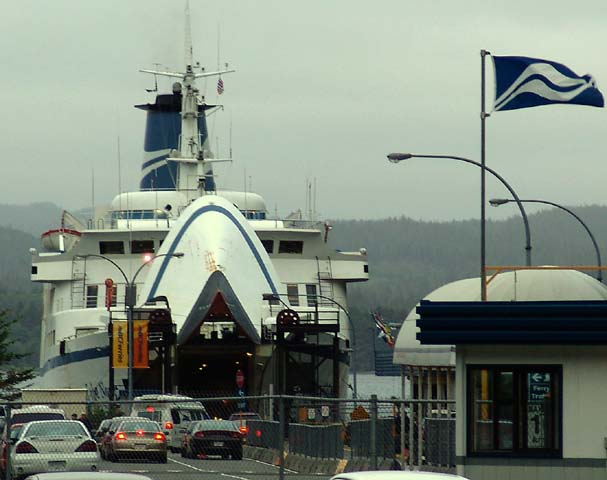
Victoria to Prince Rupert
June 8-11
Tuesday, June 8 - we started driving up Vancouver Island to Port Hardy to
catch the BC ferry to Prince Rupert. The weather was beautiful and the drive was
quite scenic. Vancouver Island is very forested and fairly mountainous. The
mountains are not high, but we did see snow on some of them as we got further
north. The highway was much better than I had anticipated; it took us 6 1/2
hours to drive the 310 miles to Port Hardy, and we weren't trying to make time.

Vancouver Island (foreground) and the channel between it and the
mainland.
June 9: Early Wednesday morning (6 AM ugh!) we headed for the ferry. We
gave a young couple from Tasmania a ride to the ferry dock. They didn't have a
car and were traveling by hitchhiking. They had been traveling in South America
and now were seeing western Canada. Next they plan to go to India and then be
back in Tasmania about Christmas. That must be the life! I asked about whether
they had much difficulty getting rides, but they said it had not really been
much of a problem.

Loading the ferry. The weather was terrible - cold and heavily
overcast. The chances for seeing much scenery from the ferry very didn't look
very
good.

Fortunately, the skies cleared some in the afternoon and we got
to see some very pretty mountain scenery. The ferry travels up the "Inside
Passage", which is a narrow channel protected from the open ocean by an almost
continuous series of islands. It was a little choppy crossing Queen Charlotte
Sound, but the rest was very smooth.
Comments on the ferry: the trip took 15 hours to go 315 miles. We ate breakfast and dinner in the dining room; the food was served buffet style (so you could eat all you wanted) and was very good. We opted for reserved seats (at a cost of $15 per person) in the North Star lounge, rather than take our chances in the open seating lounges. On the BC web page the lounge looked very comfortable and with excellent views of the passing scenery. If we do this again, I would skip the reserved seats and head for the regular lounge. The seats were very uncomfortable; whoever designed them should have been required to sit in one for 15 hours! Furthermore, the view of the passing scenery was just as good from many seats in the regular lounge.
A concern of Roadtrekkers is what does one do about the refrigerator on long ferry rides? You can't run the refrigerator on propane because all propane has to be shut off while the RV is on the ferry. You also can't run it on electricity for more than a couple of hours or the house battery will be fully discharged, which will ruin the battery. Nancy made ice a few days ahead of time and placed it in the bottom of the refrigerator when we loaded onto the ferry. We then left the refrigerator off for the 15 hour trip. When we got to Prince Rupert we checked the ice and found that about half of it had not yet melted and the food was still cold. We had nothing in the freezer; that would have most likely thawed out during the trip. So this trick of using ice to extend the cold period seems to work for ferry trips of one day or less. Once you turn the refrigerator off, you shouldn't open the door until you are ready to turn it back on. If you open the door, the cold air will spill out and be replaced by warm air, which will cause the contents of the refrigerator to warm up faster.
Prince Rupert is a major port for the Alaska ferry since it is connected to southern Canada and the U.S. by the Yellowhead highway. Many RVers' heading to southeastern Alaska drive to Prince Rupert and then catch the Alaska ferry. However, it doesn't seem to be a major stop for cruise ships; we didn't find the usual collection of t-shirt and junky gift shops. We saw one cruise ship dock while we were here, but didn't see any mobs of tourists getting off so perhaps it was only here to take on supplies.

Prince Rupert has several totem poles; this one is in front of
the First Nations' Carving Shed. Various wood carving projects were underway
inside the shed, including a pole to be sent to Vancouver. "First Nations" is
the politically correct Canadian term for Native Americans. Prince Rupert has a
very nice museum featuring the history of the area, with considerable emphasis
on the Native American history.
We also visited a salmon canning factory that has been converted into a museum. The factory operated from 1889 to the 1960s. It sure made us glad that we weren't canning factory workers; life for them was not too pleasant.